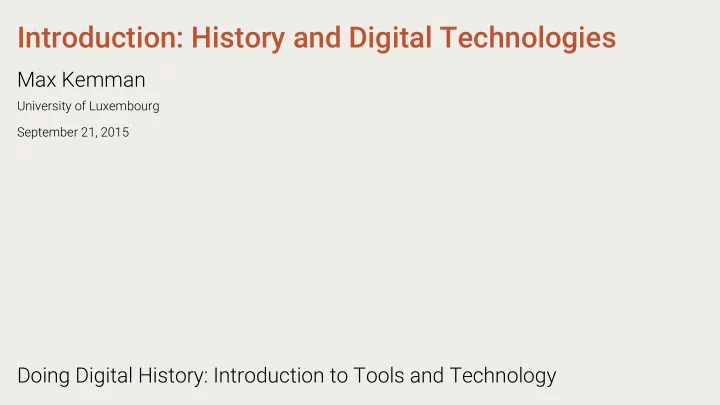

Introduction: History and Digital Technologies Max Kemman University of Luxembourg September 21, 2015 Doing Digital History: Introduction to Tools and Technology
Today • Introduction: History and Digital Technology Challenges → • Technology as support → • New practices → • About the course → • Prerequirements & Goals → • Tasks & Grading → • Overview → • Next time → •
Your lecturer Information Science PhD Candidate with Andreas Fickers Dutch or English
Introduction: History and Digital Technology What do we need all this new stuff for? Digitized archives & digital-born material
Challenges
Preservation How to preserve digital sources? • Changes in hardware & software • Cost of preservation
Complete preservation A complete historical record What would be "everything"? Does "everything" have to be preserved?
Complete preservation To think is to forget a difference, to generalize, to abstract. The challenge, likewise, for digital archives is their inability to forget —or rather, their inability to forget creatively. Anderson, S. F. (2011). Technologies of history: Visual media and the eccentricity of the past. UPNE.
Information Overload Even when we don't have everything, we get a lot What do you do with a million books? Crane, G. (2006). What do you do with a million books? D-Lib Magazine, 12(3). Or, what do you do with 31 million tweets? Maybe printing isn't the solution...
Information Overload The injunction of traditional historians to look at “everything” cannot survive in a digital era in which “everything” has survived Rosenzweig (2003) So, we consider alternative approaches to the historical record
Technology as support Unlike humans, computers can process a million books very fast No hermeneutic interpretation, but potential uses for: • Exploration • Presentation
Exploration How can we discover the interesting bits? For the microhistories/atomic history: which ones are of interest? And why? For the macrohistories/astrophysical history: how to gain overview? How to summarize?
Presentation How can we present history in an interesting way using digital tools? Are there methods beyond the narrative to tell a story? Can we invite readers to interact with the story and sources and be engaged with our arguments?
Visualisation In this course we will experiment with information visualisation for history Answer different questions about a body of text Notably:
What?
When?
Where?
Who?
Practices (Un)fortunately, such visualisations are not created automagically For this, we need new practices: • Making the information machine-readable • Experimenting with different views • Presenting arguments in a digital format
Biases We need to do all of this without falling for different biases: • Confirmation bias • Digital bias • Algorithmic bias This brings us to our current course...
About the course
Prerequirements & Goals No prerequirements :) Students will learn how to use and critically examine digital tools for historical research. This course is not about how to use tool X or tool Y • Try tool during lecture • Use Google when you get stuck • You can always e-mail me: let me know what you have tried
Limitations of the course Horizons in current practices of Digital History • Textual emphasis • Heuristic emphasis • End-user perspective, so no programming (but some coding)
Tasks & Grading Tasks • Reading literature • Keeping track of new terminology • Assignments • Group project Grading • Weekly assignments (30%) • Final group project (70%)
Overview Week 1-5: Theory of Technologies 1. Introduction: History and Digital Technology 2. Writing for the Web 3. Digital Libraries & Archives 4. Big Data 5. Distant Reading
Overview Week 6-13: Practice of Tools 6. What: Investigating what a corpus is about 7. What: Recognising entities in a corpus* 8. Where: Investigating locations in a corpus 9. Where: Creating your own map* 10. When: Investigating temporal events in a corpus 11. When: Creating an exposition* 12. Who: Investigating people in a corpus 13. Who: Networks of people*
Overview 14. Final class discussion on Tools & Technologies *Optional for BA students All slides can be found on Moodle after the lecture All literature can be found on Moodle
For next time Data: check Moodle Writing for the Web Reading: (see Moodle) • Nawrotzki, K., & Dougherty, J. (2013). Introduction. In K. Nawrotzki & J. Dougherty (Eds.), Writing History in the Digital Age (Online., pp. 1–20). University of Michigan Press. • Dorn, S. (2013). Is (Digital) History More than an Argument about the Past? In K. Nawrotzki & J. Dougherty (Eds.), Writing History in the Digital Age (Online., pp. 21–34). University of Michigan Press.
Recommend
More recommend